
38 Famous Landmarks in Europe
Europe is a continent with 44 different countries. Every country on the European continent has a rich and diverse culture and history. Going to Europe any time of the year is great for exploring those famous landmarks and you’ll have an unforgettable experience going through each country.
Picking the most famous landmarks in Europe is not easy as there are so many famous places to visit. Looking for the biggest palace? Which is the highest tower? Which are the most memorable? Here’s our list of top European landmarks you will love!
Contents
38 Famous Landmarks in Europe
France Landmarks
#1 Notre Dame
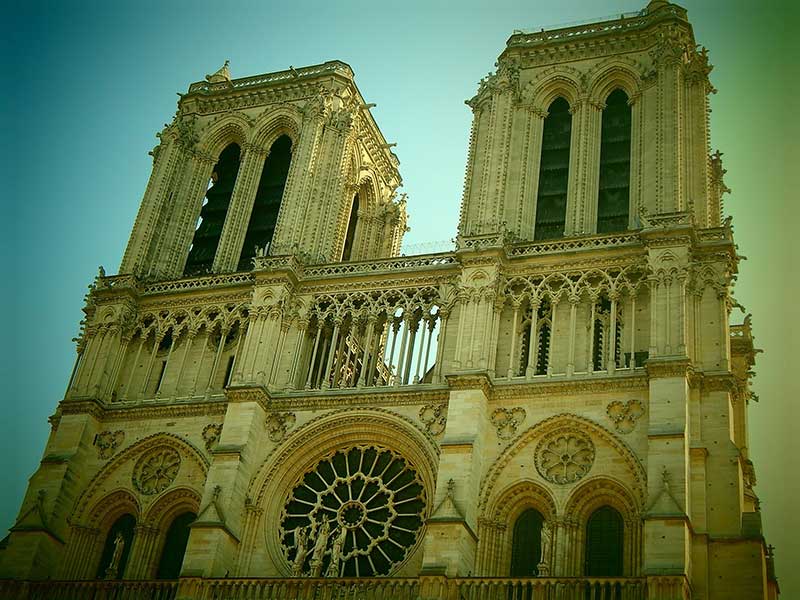
Paris has so many famous landmarks you can quickly fill your itinerary, starting with one of the top Paris landmarks, the Notre Dame Cathedral.
This is one of the world’s largest Catholic churches.
The construction took over 180 years to build and was completed in 1345 and is a stunning building with French gothic architecture.
Notre Dame is free to explore and there’s a small fee for audio guides. Tours are also available and climb the 387 steps to admire a lovely view.
#2 Eiffel Tower
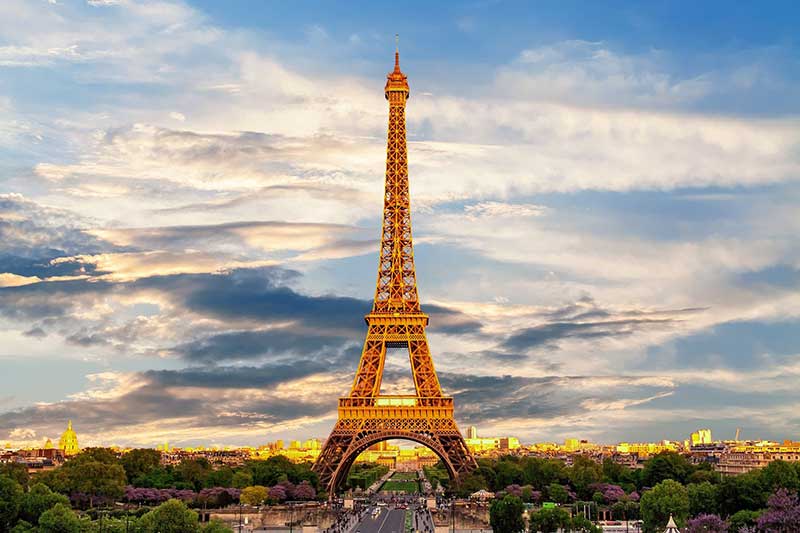
The Eiffel Tower is another famous landmark and worth seeing when you visit Europe. In addition to being located 4 km from Paris’ center, this landmark is also found in France.
The tower is the work of Gustave Eiffel, a civil engineer and architect. It attracts more than 5 million people every year.
Built in 1889, the Eiffel Tower was the world’s tallest building. When it was built, holding the title for 41 years before it was replaced by a new building located in New York City.
Visit the Eiffel Tower at night for a romantic evening. Visiting the iconic landmark after dark makes the experience and visit to Paris unforgettable.
#3 Arc de Triomphe
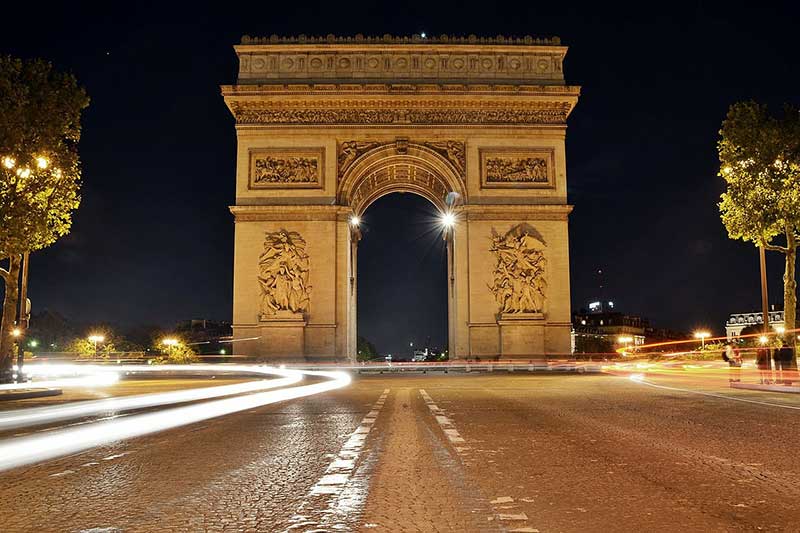
Another must-visit landmark of Europe is the famous Arc de Triomphe in Paris, France. Construction started on August 18th 1806 and ended 30 years later, on July 18th 1836.
Starting at the ground floor, you’ll climb 234 steps to reach the highest point. The names of soldiers who died in the French Revolution are etched on the walls so they will not be forgotten.
IThe architects designed a monument called the “Arc de Triomphe” to honor these brave soldiers, engraved their names on it as well as engraving
#4 Louvre Museum
When we enter this prestigious French art museum, one of the first things that bring us back to the Renaissance period is Leonardo da Vinci. His most famous work would be his paintings of the Mona Lisa and The Virgin on Rocks.
The Louvre is famous for its pyramid-shaped design and reflective glass exterior.
Aside from Leonardo da Vinci’s Mona Lisa painting, the museum holds over 30,000 pieces of artwork.
#5 Mont Saint Michel
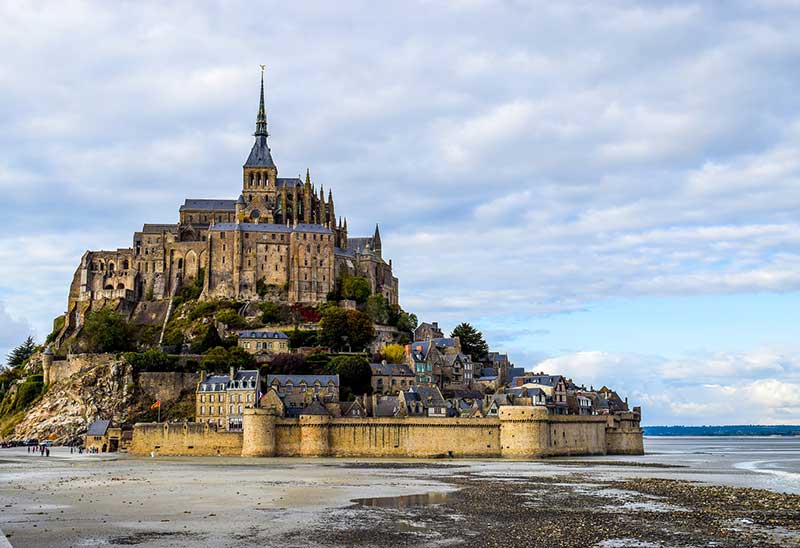
Tourists visiting Europe often make a stop at Mont St. Michelle, better known as an abbey on the island of Mont Saint Michel in France, which was completed in 1523 and features a Gothic architectural style.
The charm and popularity of this location make it popular among tourists traveling through Europe. When one visits France, be sure to view the abbey. The views are incredible throughout as well!
#6 Palace of Versailles
The Palace of Versailles was the residence of the French royal family from 1682 until it was demolished in 1778. It is located in Île-de-France and was built to be used by Louis XIV.
The Palace is outside of Paris and began live as a hunting lodge before it was transformed into a palace in 1634.
The Palace of Versailles offers two options to visitors: an audio tour, or self-guided exploration. Save on the cost of admission by visiting during the off-season or if you’re traveling on a budget.
England Landmarks
#7 Buckingham Palace
Buckingham Palace in London, United Kingdom. The palace was the official residence for many sovereigns from 1837 to the present day. Queen Victoria was the first royal to live in Buckingham Palace.
One reason to visit Buckingham Palace is that there is a ceremonial guard change performed in front of your eyes every day.
As an added perk, you can explore the royal gardens, which cover 39 acres.
#8 Big Ben
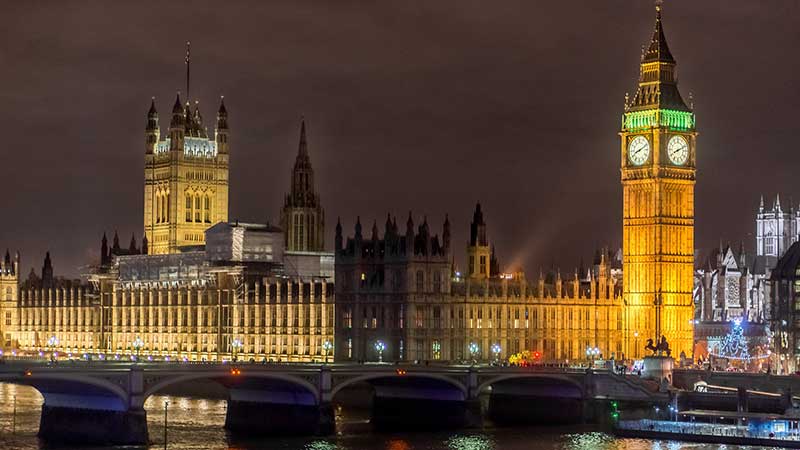
Big Ben was once known as the Great Bell. It is now the third-largest free-standing clock tower in all of Europe. Big Ben also rings on every hour and at noon.
Construction on Big Ben began in 1843 and was finished in 1856. As one of England’s most iconic landmarks, it is one of Europe’s most famous structures.
If you’re traveling to London, visiting Big Ben is a great way to learn about history. During WWII, yhe tower became a symbol of hope.
Seeing England’s famous landmarks during the day might seem impressive, but coming at night or during the holidays can make a bigger impression.
#9 – Palace of Westminster
The Palace of Westminster, or the Houses of Parliament in London, is home to two houses: the Upper House and Lower House. The parliament building was built in 1847 and houses over 1,200 rooms and 11 courtrooms.
The building was constructed in 1834 and burnt down in a fire, with only one Chapel surviving in the Incident.
If you are a traveler visiting London and love the subject of politics, one place you should not miss is Westminster Palace.
Visiting London and the UK? Consider starting or ending your trip with a day trip to Oxford, Cambridge, York, or any other nearby location.
#10 Stonehenge

Stonehenge is an ancient, prehistoric monument in Wiltshire, a county in the UK. This UNESCO World Heritage Site is very old, dating back to 3000 and 2000 BC.
Stonehenge is known for the massive stones that make up a large ring. It was built as a burial site over 5,000 years ago, but now it is a popular landmark in all of Europe.
Visitors of the monument, which displays some of the darkest periods in American history, will also have access to an accompanying museum and a tour guide’s commentary.
Ireland Landmarks
#11 St Patrick’s Cathedral
St Patrick’s Cathedral in Dublin was founded in 1191 and is Ireland’s largest church. It remains an influential landmark for most Irish people and tourists alike.
This cathedral has soaring spires, beautiful stained glass windows and ornate statues; Swift is also buried there as well as the Dean of the Church in the first half of the 1700s.
This cathedral is the only one in Ireland that still holds a daily sung service.
Belgium Landmarks
#12 Grand Place, Brussels
Brussels’ grand square, aptly named Grand Place, has been a central meeting point for Belgium traders since its 11th-century inception.
The square was a vibrant hub during the 13th century as stone and wood buildings were constructed around the perimeter, serving as a foundation for large impressive buildings present today.
As one of the city’s most prominent landmarks, the Grand Place has been a witness to several historic events. Back in 1823, it was at the square where Protestant martyrs Hendrik Vos and Jan van Essen were burned alive during an Inquisition that took place here.
The Grand Place is one of the best places to start exploring and is the top monument to see on a weekend in Brussels.
If you are staying in Belgium for a longer period of time, make sure to visit Bruges and Ghent as well.
Vatican City Landmarks
#13 St. Peter’s Basilica and Square
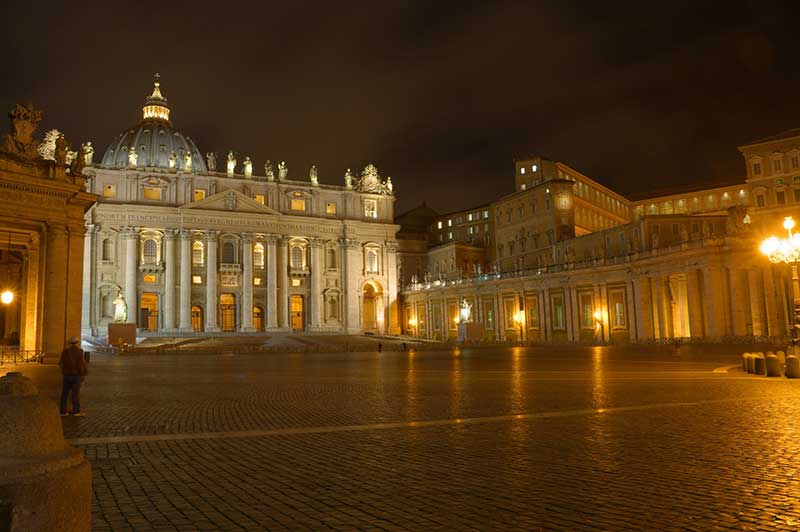
Vatican City is a country created for the Catholic religion and is officially known as ‘The Papal Basilica of Saint Peter’, Catholics built Saint Peter’s Basilica as an expression of their faith in God.
Construction of St. Peter’s Basilica started in 1506, but it wasn’t completed until 1615 under Pope Nicolas.
St. Peter’s Basilica is the most well-known Christian church in the world.
It’s an excellent example of architecture and artwork worth exploring!
As head of the Catholic Church, there are some perks to being a pope.
The Papal Palace is the residence of the Pope. It is located in Vatican City near Rome, Italy. You will also find the Vatican Museums and Library here and many other important buildings in this enclosed complex.
The Vatican Museums has over 50 galleries with works that date back to 1450. These include Leonardo da Vinci and Raphael’s work, along with a wide selection of other famous artists’ pieces which are on display in the museum as well as stunning gardens located off the main complex that extends upwards of 55 hectares.
#14 The Sistine Chapel
The Sistine Chapel, located in the Apostolic Palace of Vatican City, was named after Pope Sixtus, who ordered the restoration of the chapel in the 15th century. The frescoes inside are among the best in the world.
When visiting the Chapel, pause and find a seat somewhere around the edge of the building. Look up at frescoes while absorbing the peace that naturally surrounds this place.
Italy Landmarks
#15 Pantheon
The Pantheon is a church located in Rome, Italy. It was built after it became a Roman temple commissioned by Marcus Agrippa.
The Pantheon, a landmark in Europe with over 2200 years of rich history, was commissioned by Roman Emperor Hadrian during the first century AD.
One of the most important landmarks to visit when you are traveling in Italy is the Pantheon. This forms a key part of Italian history, as it is among the country’s oldest and more prominent monuments. As visitors enter through this iconic site, they’ll notice something that we see everywhere – light.
#16 Colosseum

In the past, theatres and stadiums were used for different purposes. Amphitheaters were used for sporting events and plays. Today you can still find an example of this in Rome at the Colosseum, which was originally intended as a venue to host both spectacles.
The Colosseum is the world’s biggest amphitheater, which was actively used during the Roman Empire and is located in the center of Rome and is one of Rome’s iconic landmarks.
It’s popular with both visitors and locals often visit the Colosseum too because the cost of living in Rome is reasonable, making it fairly affordable for anyone to explore.
#17 Trevi Fountain

The Trevi Fountain is an iconic landmark in Rome that attracts travelers worldwide. It’s a common stop on walking tours, and it has appeared in Hollywood films.
In 1629, Pope Urban VIII reportedly determined that the marble fountain on top of St. Peter’s Square was not dramatic enough and hired an Italian architect to create a different design but the project was abandoned when the pope died in 1644.
Pope Clement XII, in 1730, organized another competition to redesign the fountain that had designs inspired by drawings from 1629. The fountain was completed by 1762 and has stayed like that ever since.
#18 Florence Cathedral
Construction of the Florence Cathedral began in 1296 and ended in 1436, making it one of Italy’s most famous landmarks. The Gothic cathedral is a must-see when visiting Florenc.
The exterior of the cathedral features a range of different colors, but all are muted in contrast to the interior which is plain. This would be an excellent choice if you’re looking for a low-cost place with great views and no entrance fee!
#19 Leaning Tower of Pisa
The Leaning Tower of Pisa is an ancient bell tower and one of the most recognizable monuments in Italy.
The bell tower is popular because of its tilt. Engineering mistakes caused the building’s lean and has been corrected many times over the years to keep it stable for tourists.
The tower also has around 300 steps that lead to the top of the structure with breathtaking views of Pisa.
Hungary Landmarks
#20 Buda Castle
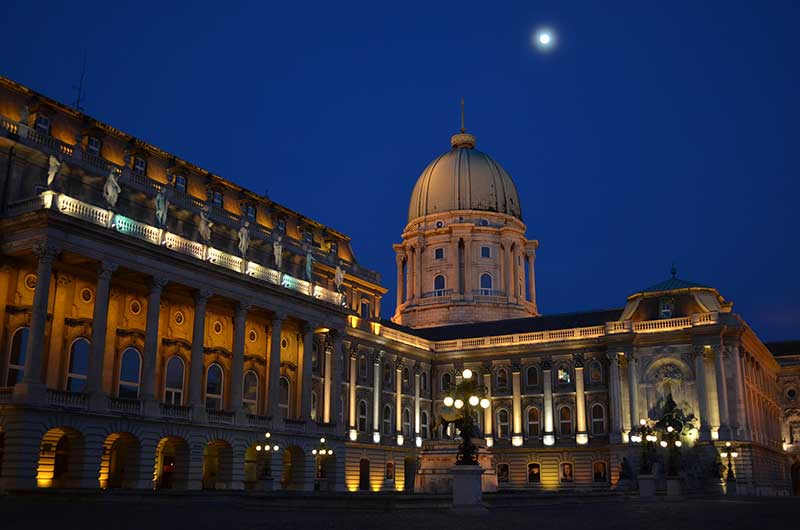
Buda Castle is an ancient monument in Budapest commissioned by Hungarian kings. Construction began on the castle in 1265 and was completed by 1769, with improvements continuing. Only a fraction of the inside of the complex is on display to see.
If you want to learn more about the history of Hungary, visit the galleries and museums housed inside Buda Castle.
Budapest is a beautiful, historic city with many lovely baths.
#21 Hungarian Parliament
The Hungarian Parliament Building is the world’s third-largest parliament building. It also has a library and conference rooms.
Located on Kossuth Square in Budapest on the Danube River, it is one of Hungary’s most famous landmarks and houses an impressive collection of books and political memorabilia.
The National Assembly building is a stunning piece of architecture. The inspiration for the house-like design is drawn from England’s Houses of Parliament, and it features a neo-Gothic style with more than 860 rooms.
If you want to explore Parliament, you can do so with tours running each day from 8 am to 6 pm. But just admiring the building’s exterior is also recommended. The parliament building may not be as globally known as other famous landmarks in Europe but it should still be on your must-see list.
Austria Landmarks
#26 Schönbrunn Palace
Habsburg rulers left an impactful mark on European history. The Schönbrunn Palace was theirs as a summer residence. The palace is a tourist site that attracts people from all over.
Even with only a short time in Vienna, it would be worth your time to visit this palace! You can enjoy a walk through the gardens surrounding the Palace once you have explored their interior.
As it was the summer residence of the Habsburg rulers, there is a lot to see. In warmer weather, visitors can enjoy the blooming flowers that decorate the gardens surrounding Schloss Leopoldskron.
Arrive early and explore the grand tour first when visiting the gardens. The crowds start to build in the gardens later on in the day, so it’s better for sharing if groups are larger there than if you only share them with a small group.
Visitors to Europe will be surprised by the grandeur of Schönbrunn Palace.
Germany Landmarks
#27 Brandenburg Gate
When in Berlin, visitors cannot miss the Brandenburg Gate. This monument was ordered by Frederick William II of Prussia who built it for royal purposes during the 18th century.
It has witnessed many historical events ranging from the French Revolution to Germany’s Cold War era.
This famous European monument is always open and the best time to visit it is during New Year’s Eve. Walk around the gate and enjoy the serene atmosphere of this city.
#28 Neuschwanstein Castle
In Bavaria, a 19th-century palace inspired Disney’s Sleeping Beauty castle.
You cannot miss Neuschwanstein Castle when exploring Germany’s imperial history. Ludwig II built the castle, which is , and it is the perfect family-friendly way to explore Bavaria–just a short drive away from Munich.
If you are already in Munich, take a day trip to Neuschwanstein Castle. Not only will the castle satisfy your appetite for adventure and romance, but it’s also one of Europe’s most beautiful castles.
Greece Landmarks
#29 Acropolis in Athens
Greece is a country with many international landmarks, including Athens, that draws thousands of tourists every year.
One of the most famous landmarks in Europe is The Acropolis, located in Athens. It shows off monuments from antiquity and was created by early Greek rulers to demonstrate their power back when they were at their strongest.
One of the reasons to visit the Acropolis is because the Parthenon is an old site with a fascinating history; it was dedicated to Athena, the Greek goddess.
This temple saw construction at the beginning of 447 BC and still stands today in Athens as a living symbol for all ages.
Spain Landmarks
#30 Guggenheim Museum
From the outside, the Guggenheim Museum Bilbao is an architectural spectacle. However, on the inside, it has a lot more to offer than just its appearance. Designed by Canadian-American architect Frank Gehry in 1993, this museum is well known as one of Spain’s most modern art museums. With exhibits curated from all periods and
After construction was complete, King Juan Carlos I of Spain took the honor to inaugurate the museum in October 1997. The museum opened in October 1997 and exhibits over 200 contemporary artworks.
Guggenheim Museum is the best place if you want to see contemporary art in a fantastic destination as Bilbao is a lovely coastal city in Spain‘s Basque region.
#31 Basilica of the Sagrada Familia
The Sagrada Familia, which started construction in 1882 and is ongoing today, is a Gaudi-designed basilica designated as a UNESCO World Heritage Site.
If you are visiting Barcelona, Catalonia and plan to explore the basilica, make sure to book your entrance ticket in advance. This landmark is a must-see on any Barcelona itinerary.
Sign up for an audioguide. The Basilica of San Marco has informative signage throughout the complex, but there are some intriguing tidbits that can only be found by exploring on your own.
Barcelona is a great place to explore.
#32 Alhambra Palace, Granada
Another of the most famous landmarks in Spain, the Alhambra Palace is something you shouldn’t miss on a trip there. The building was constructed by Arabs and completed in 1238 when it served as a military base, for Nasrid kings (or queens).
Alhambra Palace is now used as a museum, where tourists can visit this marvelous European landmark each year.
The Alhambra is filled with many cultural and architectural treasures to explore, including the Generalife Palace’s gardens. I recommend taking the time to fully enjoy these places at a leisurely pace.
#33 Belém Tower
As there are many famous landmarks, it is advisable that people traveling to Lisbon spend at least 48 hours in the city.
One of Lisbon’s most highly-regarded landmarks is the Belém Tower, formally known as the Tower of Saint Vincent. The tower was used to embark and disembark Portuguese explorers for many centuries and acted as a ceremonial gateway into Lisbon.
Switzerland Landmarks
#34 The Matterhorn
One of the most revered natural landmarks in Europe is located in Zermatt, Switzerland on the border with Italy. It’s one of the sights to tick off your bucket list if you’re exploring Switzerland on a road trip.
The Matterhorn is the most famous of the mountains in the Alps. With a summit at 4,478 metres high, it also has one of the highest summits both in Europe and among the Alps. The jagged triangular mountain attracts tourists all year: from naturists to those who come up for skiing or other alpine activities during wintertime
Those looking to see the Matterhorn from higher up can take a 3,000-metre high cable car ride for as clear of an unobstructed view as possible. The shuttle also has a museum in which visitors can learn more about this region.
Czech Landmarks
#35 Prague Castle
One of the world’s largest castles, Prague Castle covers over 70,000 square meters of space. Over 700 rooms are found inside it and it sits in the Czech Republic’s capital city of Prague.
Construction on the castle has occurred in stages, but modifications continue until 1930. The resulting combination of architectural styles includes Gothic, Romanesque and Baroque.
Today, Prague Castle serves as the office of the Czech Republic’s President and is also its most popular tourist attraction in Europe.
Notably, the Crown Jewels of Bohemia are kept here. However, they are not on display and their location is a secret.
Visitors can explore the complex at this site, which includes a cathedral and a basilica. There are also gardens onsite for visitors to wander through. Tours of the complex are available daily.
#36 Charles Bridge
The Charles Bridge first started construction in 1357, but it wasn’t finished until 1402. That’s a whole 50 years!
The Bridge is a famous historic bridge that spans the Vlatava River, connecting two halves of Prague. The Austro-Hungarian-era ramparts, which provide excellent views from the heights of Prague Castle have been rebuilt as well as the entire stretch with all new railings and more than 1,000 light bulbs to illuminate walkway visitors at
Walking along Charles Bridge is an ideal activity for couples and families alike.
The Bridge is a great place to go for some peace and quiet during the week. Many weekend visitors overwhelm the natural tranquility of its environment, inviting too many people who aren’t as interested in spending time with nature.
Russia Landmarks
#37 St. Basil’s Cathedral
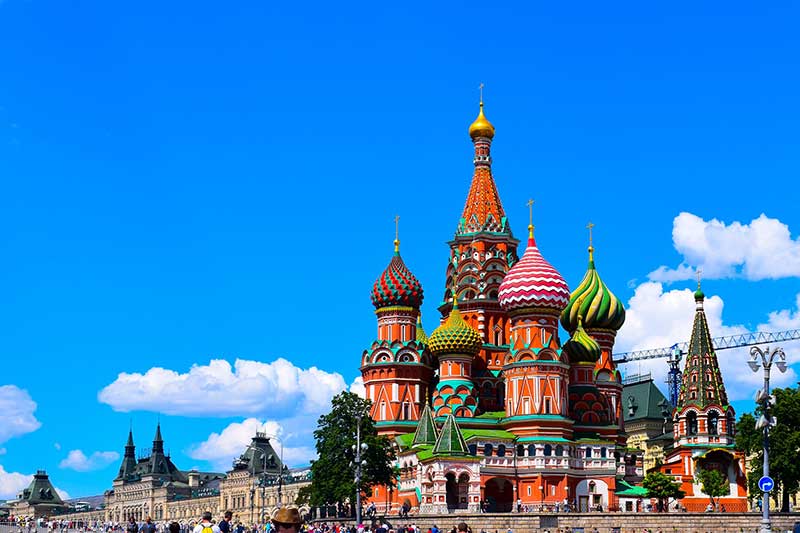
Russia’s most beautiful cathedral would also make it a top landmark in Europe.
The construction of St. Basil’s Cathedral was between the years 1550 and 1560, starting when Ivan the Terrible commissioned it mainly because of his “Great Catholic Russia” motto.
This is one of the most iconic monuments in Russia and can be found in Moscow – its official name being that of The Church of Intercession.
What makes this monument unique? First of all, it is a UNESCO World Heritage Site. The UN protects cultural and historical landmarks in Europe like this one. Second, the interior part is just as spectacular as the exterior.
#38 Peterhof Palace
The Peterhof Palace is a place and garden complex found in St. Petersburg, Russia that was commissioned by Ivan the Great in the 1700s as a homage to France’s Palace of Versailles.
The tour of Grand Peterhof Palace, Grottoes of the Grand Cascade, and other museums at Russia’s most magnificent “palace park” is worth it to see amazing Russian architecture in Europe
Once you’ve explored all the buildings, move on to enjoy the vast gardens. There are many fruit and vegetable gardens and numerous parks. Fountains can be found throughout the complex, with many featuring gold statues. After exploring some of it in one day then return another time for more exploration.



